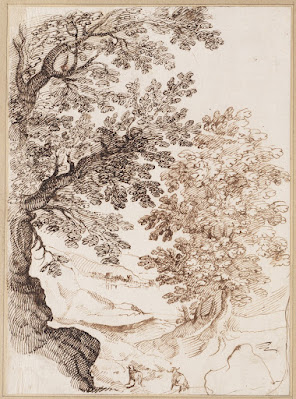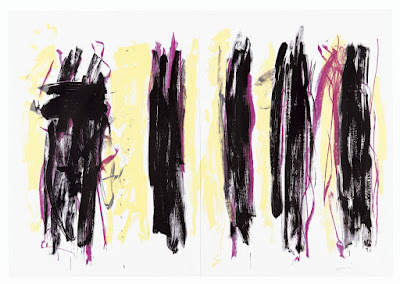 |
Joel Meyerowitz
Linden Tree, Tuscany, Fall
2002-2003
C-print
Minneapolis Institute of Art |
 |
Giovanni Penati
Piedmont
ca. 1958
gelatin silver print
Victoria & Albert Museum, London |
 |
Luigi Lucioni
Tree Rhythm
1953
etching
Fine Arts Museums of San Francisco
(Achenbach Foundation) |
 |
William Peploe
Olives near Florence
ca. 1930
oil on canvas
Yale Center for British Art |
 |
Giovanni Segantini
Pine Tree
ca. 1897
oil on canvas
Cleveland Museum of Art, Ohio |
 |
Jaime Morera y Galicia
Pines at Frascati
1875
oil on canvas
Museo del Prado, Madrid |
 |
William Stanley Haseltine
Lawn with Trees at Castel Fusano, Rome
ca. 1875
watercolor on paper
Yale University Art Gallery |
 |
Giovanni Fattori
Study of Trees
ca. 1870
oil on canvas
Pinacoteca della Città Metropolitana di Bari |
 |
Johann Wilhelm Schirmer
Cypresses in the Park at Villa d’Este, Tivoli
1839-40
drawing
Museum Kunstpalast, Düsseldorf |
 |
August Ahlborn
In the Park of the Villa Chigi, Ariccia
ca. 1831
drawing
Milwaukee Art Museum, Wisconsin |
 |
Simon Denis
Plane Tree
before 1813
oil on paper
Metropolitan Museum of Art, New York |
 |
Jacob Philipp Hackert
A Large Tree at Albano
1782
drawing
Metropolitan Museum of Art, New York |
 |
Domenico Bernardo Zilotti
Large Tree above a Stream
ca. 1780
drawing
Teylers Museum, Haarlem |
 |
Hubert Robert
Cyprus Trees with Statue of Isis
1762
drawing
Hermitage, Saint Petersburg |
 |
Aureliano Milani
Tree Study with Distant Landscape
before 1749
drawing
Metropolitan Museum of Art, New York |
 |
attributed to Andrea Locatelli
Three Trees in a Landscape
before 1741
drawing
British Museum |
Today We FlyOne Sunday morning,
instead of studying The Iliad,
I escaped with Bino to Florence,
to see what miracles the aviator Manissero
would perform.
Whether he would demonstrate the art of Daedalus
or the folly of Icarus.
We found the whole city festooned with banners
on which was written: Today We Fly.
They were everywhere: Via Cerretani,
Via Cavour, Via Calzaiuoli, along the embankments.
There was even one stretched across the Arno
with an enormous red Today We Fly
reflected in the yellow water
like the famous In Hoc Signo Vinces of Ponte Milvio.
We almost expected that Florence itself
would lift off,
with its towers, its statues, its red roofs,
with its cathedral's nodding cupola
rising slowly through the clouds
like a balloon.
Every window, doorway and marketplace
was crammed with upturned faces,
scanning the sky for some sign
of the direction the wind might take,
and whether there would come with it
the smell of rain.
We were almost afraid of the wind from Bologna,
proud enemy to the north.
Almost as bad would have been the wind from the south,
from Empoli, called the scirocco;
or Petrarch's east wind from Arezzo,
with its Grecian-accented gusts.
But even a soft westerly breeze from Pistoia –
even that sweet breath from the ballads of Cino,
full of dolce stil novo –
would have spelled disaster.
Luckily the sky that Sunday was clear,
and the air was still.
The leaves on the trees around the parade ground
stood at ease,
and the outlines of the hills were crisp,
sharply etched in the crystalline air.
Just wait. Today we really will fly,
said Bino with a smile.
For overnight Today We Fly had become a catchphrase,
fit for every occasion:
for a straw hat rolling along the pavement;
for a parasol blown around the corner;
for a dress tangled up between the knees,
or blown flapping like a flag around rounded hips.
It was the happy time of the first aeroplanes,
before the War,
when it was fashionable for women
to wear enormous hairdos
as wide as their dresses were narrow.
And those gigantic wings of hair,
which were the objects of so many of our teenage jokes,
have remained braided together in my heart
with the fluttering Today We Fly:
maliciously good-natured mementos
of my adolescence.
We hurried over the parade grounds,
and there was Manissero
crouched in the cockpit of his machine:
a contraption of woven reeds and papery cloth,
with a motor so small it made you think a horsefly
was pinned to the frame behind his shoulders.
The crowd had assembled, holding its breath,
waiting for the miracle to happen,
when suddenly the leaves began to tremble,
and the blades of grass to nod.
A few tiny white clouds sprouted
like windowsills on Monte Morello,
and the women's wings of hair began to come untucked
from their padded nests of false braids.
Manissero jumped out of his cockpit
at the first sign of this unfortunate breeze,
waved amicably to the crowd with a gloved hand,
and yanked off his leather helmet
while a banner was unfurled above the grandstands:
Because of Unsettled Weather, Today We Will Not Fly.
It was hard to imagine anything more settled
than the weather that day:
a magnificent, paradisiacal Sunday in spring.
But all it took was this delicate breeze,
this perfumed zephyr from Pistoia,
to spoil everything.
We returned to Prato with heavy hearts,
and I took up my study of the abandoned Iliad,
quiet and discouraged.
Thursday morning the rumor began to spread
that the following Sunday,
if the weather was favorable,
Manissero would attempt to fly
from Florence to Prato and back:
thirty kilometers round trip!
By Saturday, Via Magnolfi, the Corso,
Via del' Oche, Via Firenzuola – all the streets of Prato
were crisscrossed with white banners
carrying those fateful words:
Today We Fly.
By noon Sunday
rivers of people from the surrounding countryside
were flooding into the city through its five gates,
and by three o'clock
the cathedral square was awash
with a restless and noisy crowd,
pale, perspiring, noses in the air.
I stood among them with my classmates,
all of us impatient, barely kept in check
by the stern gaze of our principal
and the softer reprimands of the teachers.
We began to hear a new word:
Velivolo!
dancing above the buzz of the crowd.
But that name for aeroplane, recently coined by d'Annunzio
seemed too delicate for the gaping mouths of dumbstruck farmers:
it was still fresh, still smelled of varnish,
and was as sweet and sharp in the mouth
as mint candy.
Velivolo!
Suddenly a white wing appeared in the blue sky
and the reed-and-paper bird
grew larger, came closer,
hovered over the cathedral square.
A cry, only one, but from a thousand throats;
a cry more of fear than joy:
then sudden silence,
bursting with anguish.
Manissero was perhaps two hundred meters above our heads
and it seemed miraculous.
Miraculous not just because he was flying,
but because he was flying over Prato,
in the virgin sky of Prato!
which only the kites of children had dared to caress
until today.
As long as the flying was over Florence,
things were fine:
certain facts, in Florence, are understandable,
are legitimate, and fit within the logic of history.
But over Prato!
Over Prato where for centuries now
nothing miraculous had happened.
Not on the ground,
and not in the sky.
Especially not in the sky.
Over Prato!
Where it seemed that miracles had become impossible,
caught as we were
between the historic pride of Florence
and the ancient jealousy of Pistoia.
Sacrificed,
reduced to poor relations,
robbed not only of everything we had,
which would have been bad enough,
but of everything we might have wanted to have.
Yet here was Manissero flying in our sky,
in the neglected sky of Prato.
And he was flying, or so it seemed,
better than he might have flown in the sky of Florence.
Better than in any other sky in Tuscany!
After a moment, though, the suspicion began to grow
that he might fly as far as Pistoia.
Everyone held their breath,
balanced on one foot,
hearts stopped between beats:
The treacherous sky of Pistoia!
Some of us took out our keys
ready to rattle them against such a betrayal.
The rest of us set our lips
to whistle in defiance.
But Manissero veered to the right,
and after a wide turn over Prato
he headed back toward Florence.
The city detonated with joy.
I lost myself in the crowd, beyond thought,
proud citizen of Prato to my bones.
It wouldn't be too much to say that all of us, that day,
felt we held a piece of sky in our hands.
That night, in my dreams, the Achaean army,
assembling beneath the walls of Troy,
came to a halt, astonished at what lay before them:
stretching from tower to tower
immense white banners
on which great red letters spelled out:
Today We Fly.
And then Troy, the city of Priam –
which from a distance resembled nothing more than Prato –
detached itself gently from the earth,
hovered with its banners snapping in the breeze,
and drifted away into the clear sky,
swinging gently from side to side.
Maddened Achilles ran along below, commanding:
Stop! Stop!
And from the buzz of his accent
you might have though he was from Pistoia.
Beloved Priam, from the top of the Trojan gates,
answered sweetly:
Too Late. Too Late.
And his voice had all the soft accents of Prato,
taking flight.
– Curzio Malaparte (1898-1957), translated by Walter Murch (2012)































































